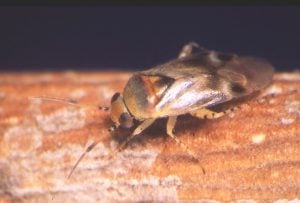Apple dimple bugs are being seen in high numbers in some areas this spring. Damage is caused by the bugs feeding on the ovaries of flowers in spring, causing dimple-like deformities on developing fruit.

Apple Dimpling Bug (Adult)

A juvenile Apple Dimpling Bug on apple leaf. ADB are considered beneficial in apple oprchards outside of the potential damaging period of Pink-Petal fall (Photo: K Dodds NSW DPI)
Adult dimple bugs are greenish-brown and about 3mm long. The bugs are small, active, and often occur in high numbers almost overnight depending on weather conditions. They have spiny legs and a generally triangular shape formed by their wing covers, They have a distinct sweet odour when squashed.
The species known as apple dimple bug in Tasmania looks quite different from its mainland cousin.
Guidelines for monitoring in apple orchards
(adapted from guidelines provided by the Department of Agriculture and Feed, Western Australia)
- Start sampling apple trees at the pink bud stage and sample twice weekly until petal fall.
- Sample in the cool of the morning (before 9.00am), as the bugs become too active for accurate identification and counting when it becomes warmer.
- Dimple bugs occur in greater numbers on the sunny side of the tree. Use the 20 flower clusters (4 clusters x 5 locations on the tree) per tree monitoring method. A white ice-cream tub is good, as bugs will be easily seen (see monitoring video below)
- Record the number of dimpling bugs found and determine whether a spray is required according to thresholds (see article Variable spray threshold for mainland apple dimple bug)
- Do not stop sampling after a spray; re-invasion from the bush is likely. Sampling after spraying will also help you to determine the effectiveness of the spray.
- Poor sampling is likely to result in underestimation of dimple bug numbers; this may lead to increased levels of damage.
- Ants deter dimple bugs. If ants are found in the sampling container, move to another tree.
- Monitoring of alternative hosts is useful in both mainland Australia and Tasmania. For mainland Australia, wattle trees and tree Lucerne should be carefully monitored.
- When doing the dimple bug sample, check for thrips too. If doing in early morning when temperatures are cool, gently blow into flower as your warm breath will make thrips move around (they may not come out just when tapping).
Thresholds
Previous attempts to develop thresholds for ADB were based on the number of bugs detected by blossom jarring but this proved problematic due to variation in the length of the flowering period and inclement weather sometimes interfering with sampling. To overcome this a threshold based on bugdays (cumulative bug activity) over the flowering period was developed in NSW.
To calculate bugdays see our article Variable spray threshold for mainland apple dimple bug
The very low threshold between pink and full bloom generally justifies a prophylactic spray being applied at late pink and then the use of the variable threshold to determine if a further spray is required later in the flowering period. It is important to minimise the number of sprays applied because those sprays can have a drastic impact on the survival of predatory mites that control two spotted and European red mites, and parasitic wasps that control other pests. Chemicals other than fluvalinate are now registered against ADB and the spray thresholds for those products are likely to be higher, although they have not yet been determined.
Further Information
See our article Variable spray threshold for mainland apple dimple bug
See our page on Pest Monitoring Guidelines with downloadable Monitoring Guidelines factsheet and downloadable Monitoring Sheet template
See Managing Apple Dimpling Bug article by Department of Agriculture and Feed, Western Australia

Apple Dimpling Bug damage (Photo: Susie Murphy-White, PomeWest)
Article reviewed by Greg Lefoe (Agriculture Victoria)
